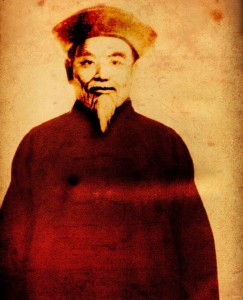Wu/Hao Style Tai Chi Chuan
 Wu/Hao Style Tai Chi Chuan was founded by Wu Yuxiang (1812-1880) who was a native of what is now called Guangfu Town, Yongnian County, Hebei Province. This town was also home to Yang Luchan, founder of Yang Style Tai Chi Chuan. Wu Yuxiang and his two brothers began studying under Yang Lu Chan. Later, Wu Yuxiang learned from Chen Qingping at the Zhaobao village.
Wu/Hao Style Tai Chi Chuan was founded by Wu Yuxiang (1812-1880) who was a native of what is now called Guangfu Town, Yongnian County, Hebei Province. This town was also home to Yang Luchan, founder of Yang Style Tai Chi Chuan. Wu Yuxiang and his two brothers began studying under Yang Lu Chan. Later, Wu Yuxiang learned from Chen Qingping at the Zhaobao village.
Wu Yuxiang was a wealthy scholar. He didn’t teach many tai chi students but used his scholarly talents to write a lot about tai chi chuan theory as well as other tai chi styles. His Tai Chi Chuan was made famous mostly through the efforts of the Hao family. Hao Weizhen (1842-1920) learned Wu Yuxiang’s style from Wu’s nephew Li Yiyu. Hao Weizhen passed his knowledge to his son Hao Yueru and grandson Hao Shaoju. He also taught this style to Sun Lutang, the founder of Sun style.
Wu/Hao Style Tai Chi Chuan is distinctive with small, subtle movements. It is slow, smooth, small, and focused on balance, sensitivity, and internal qi development. With its high postures, it appeals to those who regard the lower-stance styles as being hard on the knees. Wu/Hao Style Tai Chi Chuan is one of the major styles practiced, though it is rare compared with the other major styles and is still relatively unknown in the West.
Today, Zhong Zhenshan and Wu Wenhan are both 5th generation Grandmasters of Wu/Hao Style Tai Chi Chuan and Zhong Zhenshan is the 5th generation lineage holder of the style.
Wu/Hao is a term unique to the West. In China, both Wu/Hao and Wu styles are called Wu after their founders Wu Yuxiang and Wu Jianquan. However, the Wu names have different pronunciations. In Chinese:
Wu/Hao =Wǔ
Wu = Wú
In English, there are no different pronunciations for Wu as in Chinese, so we have distinguished the two Wu’s by another way. Thus “Hao” has been added, named after Hao Weizhen who helped popularize Wu Yuxiang’s style, but did not develop it differently from its Founder.
